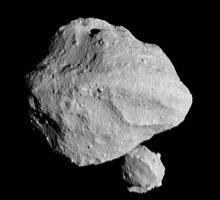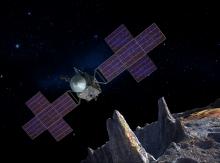Listen to today's episode of StarDate on the web the same day it airs in high-quality streaming audio without any extra ads or announcements. Choose a $8 one-month pass, or listen every day for a year for just $30.
You are here
Radar Asteroids
Hundreds of big space rocks follow paths that bring them close to Earth. And it’s possible that some of these rocks could someday hit our planet. Such an impact could cause destruction on a regional or even global scale.
One of the best ways to study and track these potential killers is with radar. Scientists use big radio telescopes to beam pulses of energy at the target. Some of the radio waves reflect back to the telescope. In some cases, scientists use two telescopes — one to send out radio waves, and another to catch their reflection.
Those waves can reveal the asteroid’s size, shape, and something about its composition. Most important, they also help measure the asteroid’s position with a high degree of accuracy. That provides a good plot of its orbit, letting us know if the asteroid might threaten us in the future.
The first radar observations of an asteroid took place 50 years ago this week, with radio telescopes in Massachusetts and California. They looked at 1566 Icarus, which was passing just a few million miles from Earth.
The initial observations were crude, and some of them turned out to be wrong. But radar scans during another close pass, in June of 2015, revealed a lot more. Icarus is an oddly shaped chunk of rock that’s about a mile long. It spins once every two and a quarter hours. And it orbits the Sun once every 1.1 years — a potentially troublesome asteroid that we keep an eye on with radar.






